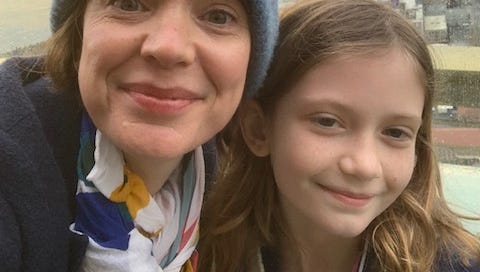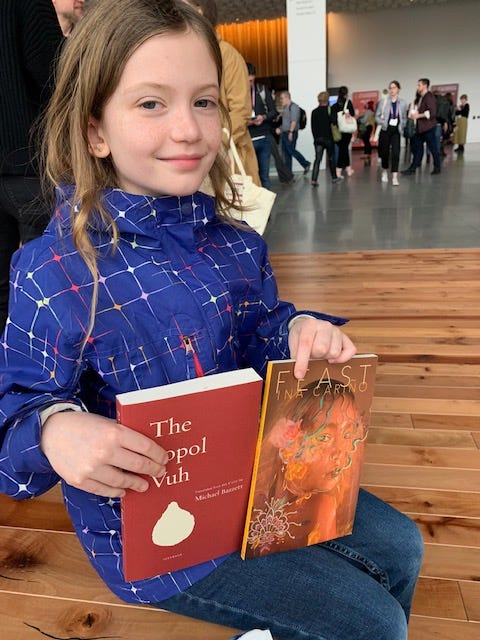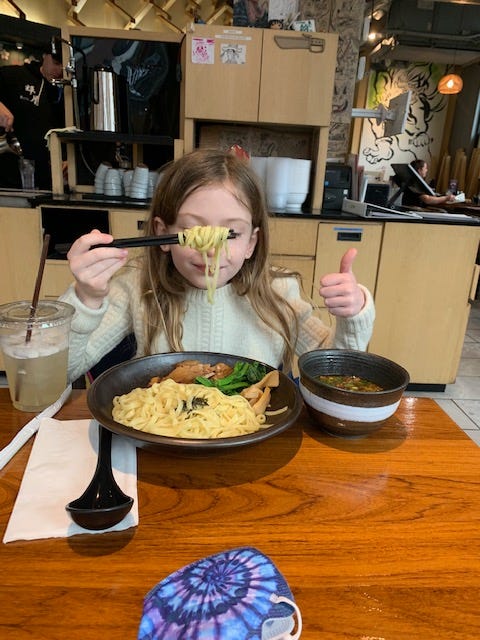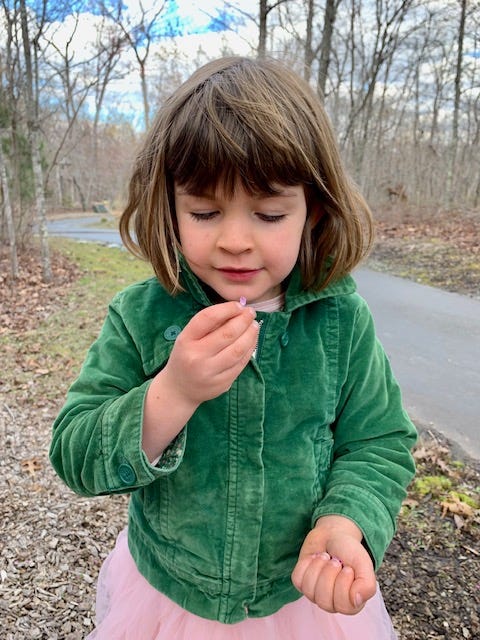The heart of the annual AWP (Association of Writers and Writing Programs) conference is the massive book fair. “This place puts the Scholastic book fair to shame,” Bea told me when we first went inside. It’s easy to spend hours wandering the huge room, which is filled with booths advertising work from different presses, magazines, and writing programs, each one helmed by one or two writers and editors (who were probably itching for the chance to wander themselves). I picked up postcards and flyers advertising contests to take back to my students. Bea gathered candy and trinkets. We bought some great books too—Feast, a brilliant new poetry collection by NC State grad Ina Cariño, Hot Comb, an acclaimed graphic novel by Ebony Flowers.
“Which one of you is the writer?” we were asked more than once. Bea would stare at the questioner from behind the mask she wore hitched up to her bottom lashes until they slid her a piece of candy or two. “Oh, we both are, ha ha,” I’d say, before steering her the next booth. (Bea doesn’t like being identified as “the kid”—she hates to be told “good job!” when she’s riding her mountain bike or otherwise singled out as the youngest in a group.)
But I thought of this question during what was, for me, the most important and useful event I attended while we were in Seattle: the annual meeting of the Writers in the Schools (WITS) Alliance. I’m not a member of WITS, though I hope to start a program for writers in the school next year, at NC State, through a graduate class I’m teaching in the fall. WITS programs serve public K-12 schools, bringing professional writers into classrooms and offering intensive arts instruction to students.
I first taught in a WITS-like program when I was in grad school in California. Our program was called Humanities Out There (HOT), and we taught everything from the text of the Popol Vuh to contemporary poetry and short stories in elementary, middle, and high schools in Santa Ana. I still have the anthology we published, and I can still (just about!) recite some of the awesome poems our students wrote. Like this one:
My Bad Haircut
by Perla Livingston, Grade 3
I got a hair cut
that was short
and curly.
People said
it was
ugly.
But that
was their
problem.
Perla wrote that in 2002. She was Bea’s age then, eight or nine, making her… 29 now!? I wonder what she’s doing, if she’s still writing, if she has a good and happy life. I hope so.
One of the core principles of WITS is that “a literary education is the birthright of every child.” They emphasize this through reading diverse authors with kids, presenting diverse authors to them as teachers, partnering with classroom teachers to design curriculum, and planning public celebration of student writing (so important, this celebration part).
Unlike some of the other excellent panels we attended, this one wasn’t standing-room-only. It wasn’t hosted in a giant room. The tech was simple, a projection of a Zoom screen for teachers from New York and San Francisco who weren’t able to attend in person. We dragged chairs into a circle (there were about twenty people in attendance) and introduced ourselves and our reasons for being there. Some of the members were teaching artists, others were executive directors of WITS programs. There was a K-12 teacher from Washington and a speech pathologist and poet looking for new ideas for working with disabled kids. We talked about the challenges of providing these programs, from raising money for programming to training and retaining teaching artists. “Look to sports teams for fundraising!” a teacher on Zoom advised. “They always have money!” There was so much to say that we went a little over the allotted time limit.
But part of the plan for the meeting was to host a reading of student work, and I was impressed that even though people had other places to be—other panels, other readings, the big book fair downstairs—these teaching artists eagerly pulled printed pages and student-made anthologies out of their tote bags and settled in to read and listen. A “where I’m from” poem that one teacher read knocked us flat. A poem about living on the margins in Marin County made us gasp with its last line. These teachers were of course all writers themselves—poets and essayists and novelists and short story writers—but to them, at least for this panel, the work that mattered was the work of their students.
Which one of you is the writer? is an essential question to think about whenever you’re with young people. Because the book bans that are happening across the country are not targeted—not really—at writers like Maia Kobabe and George M. Johnson and Toni Morrison and Margaret Atwood. They’re laser-focused on kids, not only as readers but as future writers of the stories and poems we all need to hear and pay attention to.
The target is not novels like memoirs like Gender Queer or novels like The Bluest Eye. The ultimate goal is the future books, the future voters, the future truth-tellers. And their teachers, of course.
Next year’s AWP is scheduled for Kansas City, Missouri. A state that leads the nation in anti-trans legislation, and where anti-LGBTQ+ laws may prevent trans writers from legally reading their work at the conference. A state where it may soon be impossible for trans kids to receive gender-affirming healthcare. I’m not sure what will happen with AWP (some have called for it to boycott the state, others to stay and fight for the safety of all members), but I am listening/following along with the trans- and non-binary-led conversations about what will work best for the community.
Because trans people, trans kids, and trans writers are everywhere. Writers are everywhere too, especially in our public schools. If you want to read more about the work of teaching artists or get some great ideas for the classroom check out the WITS program nearest to you or subscribe to the Teachers and Writers free, online magazine.
More soon from us—Bea and Harriet have the day off tomorrow so I think we can put together a Tuesday post for you.
P.S. Harriet would like to remind you that it’s redbud season, and the blossoms are edible and delicious:
See you soon, Frog Troublers! How is the almost-spring treating you?








awesome issue 💜 love reading of AWP and writers’ adventures in seattle!
Catching up with your newsletters made for a good morning!